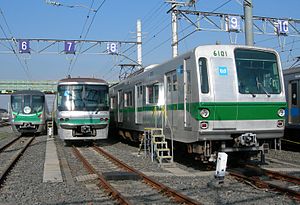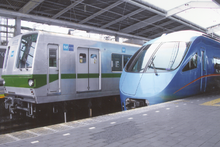- Tokyo Metro Chiyoda Line
-

Chiyoda Line
千代田線
A lineup of Chiyoda Line rolling stock: 16000 series, 06 series, 6000 seriesOverview Type Heavy rail rapid transit Locale Tokyo Termini Yoyogi-Uehara
Ayase (main line)Stations 20 Operation Opened 1969 Owner Tokyo Metro Depot(s) Ayase, Yoyogi Rolling stock Tokyo Metro 6000 series, Tokyo Metro 06 series, Tokyo Metro 16000 series Technical Line length 24.0 km (14.91 mi) (main and branch) Track gauge 1,067 mm (3 ft 6 in) Electrification 1,500 V DC overhead catenary Operating speed 80 km/h (50 mph) Route map Chiyoda Line route map Legend
Odakyu Odawara Line for Odawara 
(C-01) Yoyogi-Uehara Odakyu Odawara Line 








Yoyogi-Hachiman Odakyu Odawara Line for Shinjuku 


Yoyogi Depot 



(C-02) Yoyogi-Koen 


Harajuku JR Yamanote 
(C-03) Meiji-Jingumae 

(C-04) Omotesando 


(C-05) Nogizaka 
(C-06) Akasaka 


Tameike Sanno 


(C-07) Kokkai-gijidomae 



Servicing connection to Yurakucho Line 
(C-08) Kasumigaseki 


(C-09) Hibiya 




Yurakucho  JR Yamanote and Keihin-Tohoku
JR Yamanote and Keihin-Tohoku
Nijubashimae (C-10) 


(C-11) Otemachi 






Awajicho 




(C-12) Shin-Ochanomizu 


Ochanomizu JR Chuo 
(C-13) Yushima 
(C-14) Nezu 
(C-15) Sendagi 


(C-16) Nishi-Nippori JR Yamanote and Keihin-Tohoku 


(C-17) Machiya Keisei Main Line, Toden Arakawa Line 





Joban Line/Hibiya Line/Tobu Line for central Tokyo 


(C-18) Kita-Senju  JR Joban, Tobu Isesaki Line, Tsukuba Express
JR Joban, Tobu Isesaki Line, Tsukuba Express








Arakawa River 


Central Circular Route 


Ayase River 


Shuto Expressway Line 6 Misato Route 


(C-19) Ayase 


Ayase Branch Line splits from Joban Line 


(C-20) Kita-Ayase 


Ayase Depot 


Joban Rapid and Local Line for Matsudo, Abiko, Toride The Chiyoda Line (千代田線 Chiyoda-sen) is a rapid transit line owned and operated by Tokyo Metro in Tokyo, Japan.
Contents
Overview
The 21.9 km main line serves the wards of Adachi, Arakawa, Bunkyō, Chiyoda, Minato and Shibuya, and a short stretch of tunnel in Taitō with no station. A 2.1 km branch line between Ayase and Kita-Ayase is located in Adachi. Its official name, rarely used, is Line 9 Chiyoda Line (9号線千代田線 9-gō sen Chiyoda-sen).
On maps, diagrams and signboards, the line is shown using the color green, and its stations are given numbers using the letter C.
Trains have through running onto other railway lines on both ends. More than half of these are trains to the northeast beyond Ayase onto the East Japan Railway Company (JR East) Jōban Line to Toride. The rest run to the southwest beyond Yoyogi-Uehara onto the Odakyū Electric Railway Odawara Line to Hon-Atsugi and to Karakida on the Odakyū Tama Line.
According to the Tokyo Metropolitan Bureau of Transportation, as of June 2009 the Chiyoda Line was the second most crowded subway line in Tokyo, at its peak running at 181% capacity between Machiya and Nishi-Nippori stations.[1]
Basic data
- Distance: 24.0 km (14.91 mi)
- Main line: 21.9 km (13.61 mi)
- Branch line: 2.1 km (1.30 mi)
- Double-tracking: Entire line
- Railway signalling: CS-ATC
History
The Chiyoda Line was originally proposed in 1962 as a line from Setagaya to Matsudo, Chiba Prefecture: the initial name was Line 8. In 1964, the plan was changed slightly so that through service would be offered on the Jōban Line north of Tokyo, and the number was changed to Line 9.
Line 9 was designed to pass through build-up area in Chiyoda, and also intended to relieve the busy Ginza Line and Hibiya Line, which follow a roughly similar route through central Tokyo.
The first stretch was opened on December 20, 1969 between Kita-Senju and Ōtemachi. The line was almost completed by October 10, 1972 when it reached Yoyogi-Kōen, although the 1 km section to Yoyogi-Uehara was not completed until March 31, 1978. The branch line to Kita-Ayase was opened on December 20, 1979.
On May 15, 2006, women-only cars were introduced on early-morning trains from Toride on the Jōban Line to Yoyogi-Uehara.
From March 18, 2008, Odakyū Romancecar limited express services began running between Kita-Senju and Hakone-Yumoto (on the Hakone Tozan Line) and Karakida (on the Odakyū Tama Line. Trains also run from/to Shin-Kiba using tracks connecting to the Yūrakuchō Line. It is the first time that reserved-seating trains have operated on a Japanese subway line.
Station list
- All stations are located in Tokyo.
- Stopping patterns:
- Local trains stop at every station.
- Odakyū Romancecar limited express services stop at stations marked "●" and does not stop at those marked "|".
- The Odakyū Bay Resort limited express service does not stop at stations marked "▲". (It leaves the Chiyoda Line at Kasumigaseki.)
- All limited express services stop at Yoyogi-Uehara to change drivers and conductors, but passengers may not board or disembark at this station.
Main line
Station
NumberStation Japanese Distance (km) Limited
ExpressTransfers Location Between
StationsTotal C-01 Yoyogi-Uehara 代々木上原[* 1] - 0.0 ※ Odakyū Odawara Line (through services for Hon-Atsugi and via the Tama Line for Karakida; limited expresses via the Hakone Tozan Railway for Hakone-Yumoto) Shibuya C-02 Yoyogi-Kōen 代々木公園 1.0 1.0 | C-03 Meiji-Jingūmae 明治神宮前 1.2 2.2 |  Tokyo Metro Fukutoshin Line (F-15)
Tokyo Metro Fukutoshin Line (F-15)
Yamanote Line (Harajuku)C-04 Omotesandō 表参道 0.9 3.1 ●  Tokyo Metro Hanzōmon Line (Z-02),
Tokyo Metro Hanzōmon Line (Z-02),  Tokyo Metro Ginza Line (G-02)
Tokyo Metro Ginza Line (G-02)Minato C-05 Nogizaka 乃木坂 1.4 4.5 | C-06 Akasaka 赤坂 1.1 5.6 | C-07 Kokkai-Gijidō-mae 国会議事堂前 0.8 6.4 |  Tokyo Metro Marunouchi Line (M-14),
Tokyo Metro Marunouchi Line (M-14),  Tokyo Metro Namboku Line (Tameike-Sannō: N-06),
Tokyo Metro Namboku Line (Tameike-Sannō: N-06),  Ginza Line (Tameike-Sannō: G-06)
Ginza Line (Tameike-Sannō: G-06)Chiyoda C-08 Kasumigaseki 霞ケ関 0.8 7.2 ▲  Tokyo Metro Marunouchi Line (M-15),
Tokyo Metro Marunouchi Line (M-15),  Tokyo Metro Hibiya Line (H-06)
Tokyo Metro Hibiya Line (H-06)C-09 Hibiya 日比谷 0.8 8.0 |  Tokyo Metro Hibiya Line (H-07),
Tokyo Metro Hibiya Line (H-07),  Tokyo Metro Yūrakuchō Line (Yūrakuchō: Y-18)
Tokyo Metro Yūrakuchō Line (Yūrakuchō: Y-18)
 Toei Mita Line (I-08)
Toei Mita Line (I-08)
Yamanote Line, Keihin-Tōhoku Line (Yūrakuchō)
Underground passage to Ginza, Higashi-Ginza stationsC-10 Nijūbashimae 二重橋前 0.7 8.7 | C-11 Ōtemachi 大手町 0.7 9.4 ●  Tokyo Metro Tōzai Line (T-09),
Tokyo Metro Tōzai Line (T-09),  Marunouchi Line (M-18),
Marunouchi Line (M-18),  Hanzōmon Line (Z-08)
Hanzōmon Line (Z-08)
 Toei Mita Line (I-09)
Toei Mita Line (I-09)C-12 Shin-Ochanomizu 新御茶ノ水 1.3 10.7 |  Tokyo Metro Marunouchi Line (Awajichō: M-19)
Tokyo Metro Marunouchi Line (Awajichō: M-19)
 Toei Shinjuku Line (Ogawamachi: S-07)
Toei Shinjuku Line (Ogawamachi: S-07)
Chūō-Sōbu Line, Chūō Line (Rapid) (Ochanomizu)C-13 Yushima 湯島 1.2 11.9 | Bunkyō C-14 Nezu 根津 1.2 13.1 | C-15 Sendagi 千駄木 1.0 14.1 | C-16 Nishi-Nippori 西日暮里 0.9 15.0 | Yamanote Line, Keihin-Tōhoku Line
Nippori-Toneri Liner (02)Arakawa C-17 Machiya 町屋 1.7 16.7 | Keisei Main Line
Toden Arakawa Line (Machiya-Ekimae)C-18 Kita-Senju 北千住[* 2] 2.6 19.3 ●  Tokyo Metro Hibiya Line (H-21)
Tokyo Metro Hibiya Line (H-21)
Jōban Line
Tōbu Isesaki Line
Tsukuba Express (05)Adachi C-19 Ayase 綾瀬[* 2] 2.6 21.9 Jōban Line (through service for Toride)
 Tokyo Metro Chiyoda Line (for Kita-Ayase)
Tokyo Metro Chiyoda Line (for Kita-Ayase)Branch line
Both stations are located in Adachi.
Station
NumberStation Japanese Distance (km) Location Between
StationsTotal C-19 Ayase 綾瀬 - 21.9  Tokyo Metro Chiyoda Line (for Yoyogi-Uehara)
Tokyo Metro Chiyoda Line (for Yoyogi-Uehara)
Jōban LineC-20 Kita-Ayase 北綾瀬 2.1 24.0 Rolling stock
Listed below are currently used, all are 10-car formations unless otherwise indicated. Numbers in parentheses are of formations currently in service.
- Tokyo Metro
- 06 series (x1) (since 1993)
- 07 series (x1) (since 2008)
- 5000 series 3-car trains (x2) (since 1969, currently for branchline)
- 6000 series (x35) (since 1971)
- 6000 series 3-car train (x1) (prototype of the series made in 1968, currently for branchline)
- 16000 series (since November 2010)[2]
- Odakyū
- 1000 series
- 4000 series (since September 2007)[3]
- Odakyū 60000 series MSE (since spring 2008)[4]
- JR East
- 209-1000 series (x2)
- E233-2000 series (since summer 2009)
Former rolling stock
- 207-900 series (from 1986 until December 2009)
- 203 series (from 1982 until September 2011)[5]
References
- Shaw, Dennis and Morioka, Hisashi, "Tokyo Subways", published 1992 by Hoikusha Publishing
- ^ Metropolis, "Commute", June 12, 2009, p. 07. Capacity is defined as all passengers having a seat or a strap or door railing to hold on to.
- ^ Tokyo Metro news release: 環境配慮型の新型車両16000系 千代田線に導入決定!! (Environmentally friendly new 16000 series trains to be introduced on Chiyoda Line), (21 December 2009). Retrieved 22 December 2009. (Japanese)
- ^ [1]
- ^ [2]
- ^ "203系が営業運転から離脱 [203 series withdrawn from revenue service]" (in Japanese). Japan Railfan Magazine Online. Japan: Koyusha Co., Ltd.. 28 September 2011. http://railf.jp/news/2011/09/28/152700.html. Retrieved 28 September 2011.
External links
- Tokyo Metro website (English)
Categories:- Lines of Tokyo Metro
- Rail transport in Tokyo
- Railway lines opened in 1969
- Distance: 24.0 km (14.91 mi)
Wikimedia Foundation. 2010.



